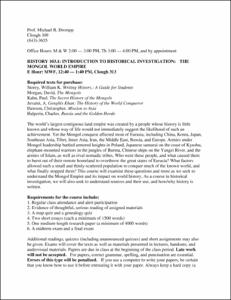Please use this identifier to cite or link to this item:
http://hdl.handle.net/10267/3173| Title: | HIST 103-01, Introduction to Historical Investigation: The Mongol World Empire, Spring 2000 |
| Authors: | Drompp, Michael R. |
| Keywords: | History, Department of;Syllabus;Curriculum;Academic departments;Text;2000 Spring |
| Issue Date: | 12-Jan-2000 |
| Publisher: | Memphis, Tenn. : Rhodes College |
| Series/Report no.: | Syllabi CRN 381031 |
| Abstract: | The world’s largest contiguous land empire was created by a people whose history is little known and whose way of life would not immediately suggest the likelihood of such an achievement. Yet the Mongol conquest affected most of Eurasia, including China, Korea, Japan, Southeast Asia, Tibet, Inner Asia, Iran, the Middle East, Russia, and Europe. Armies under Mongol leadership battled armored knights in Poland, Japanese samurai on the coast of Kyushu, elephant-mounted warriors in the jungles of Burma, Chinese ships on the Yangzi River, and the armies of Islam, as well as rival nomadic tribes. Who were these people, and what caused them to burst out of their remote homeland to overthrow the great states of Eurasia? What factors allowed such a small and thinly-scattered population to conquer much of the known world, and what finally stopped them? This course will examine these questions and more as we seek to understand the Mongol Empire and its impact on world history. As a course in historical investigation, we will also seek to understand sources and their use, and how/why history is written. |
| Description: | This syllabus ws submitted to the Office of Academic Affairs by the course instructor |
| URI: | http://hdl.handle.net/10267/3173 |
| Appears in Collections: | Course Syllabi |
Files in This Item:
| File | Description | Size | Format | |
|---|---|---|---|---|
| 2000_sp_HIST_103-01_381031.pdf | 23.07 kB | Adobe PDF |  View/Open |
Items in DSpace are protected by copyright, with all rights reserved, unless otherwise indicated.